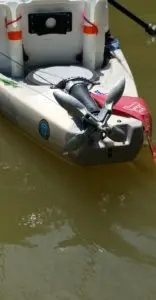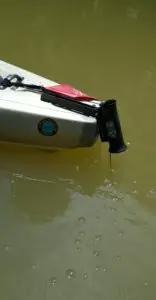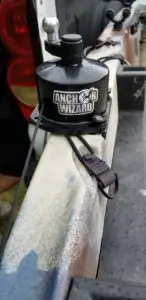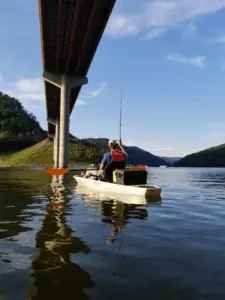Picture being right in casting range of the ‘honey hole’, the water is calm, and the weather is right. You cast your line right upstream and wait patiently for your lure to glide through the water in front of that trophy bass. When suddenly, a gust of wind nudges you just enough to catch the current. Now you’re floating down the river and will have to paddle back up. If only you had a tool that was made to keep you anchored to one spot.
In short, a kayak anchor is a must have for kayak fisherman because it allows you to stay in the exact spot you want, despite the wind, current, or waves. It is always very important for your safety. There are different anchors for each preference or situation, and using them properly will make the difference between reeling in the big one or going home empty-handed.


Safety
Let me start by saying the number one reason for having a good anchor system is your safety. If you find yourself in a particularly bad situation, where despite your best efforts, you are being pushed into something you are trying very hard to avoid, an anchor is your last line of defense. Rather it is extremely rough rapids, a drop-off, or the path of oncoming boats, you may very well find yourself dependant on your anchor to keep you away from these dangers. Just like any other safety equipment, it is best to learn how to use it properly before you need to use it to save you. Practice dropping your anchor and learn how it reacts, how long it takes to stop your kayak, etc.
The 3 Types of Kayak Anchors
The Folding Anchor
The folding anchor is the most commonly used anchor is the kayak fishing community. The anchor does its job by lying on its side and digging into the bottom. Generally, weighing between one-and-a-half-pounds to three pounds. The lighter folding anchor works well in calm areas, while the heavier will keep you immobile in more swift waters.
Let’s quickly go over some terminology, the line from the anchor to your vessel is commonly referred to as the ‘anchor rode’, and ‘scope’ is ‘anchor rode’ to water depth ratio. The common recommendation of scope is 7:1, meaning that for every 10 feet of water you would need 70 feet of anchor rode. The 7:1 ratio is more common for bigger vessels, such as johnboats, but the important thing is ensuring that this specific type of anchor has enough slack to lay on its side and dig into the bottom. You can attach a short length of chain (about 2 or 3 feet) to your anchor, and then attach your nylon rope to the chain; this will add some extra weight to the bottom and help the flukes (the arms of the anchor) stick to the bottom better. The folding anchor is designed to spin when you pull it to the surface, this helps clean all the muck off of it on its way back to the kayak.
Kayaks are designed to face the movement of the water, or directly against it. That being said, dropping your anchor off the bow(direct front of the kayak) or stern (direct rear) is the best choice. While anchoring from the side of the kayak may make sense in some situations, keep in mind it should be avoided in swifter waters. Deciding on how to deploy your anchor depends on your style of fishing and how you want your bait to be presented. For example, if you anchor from the bow you will be casting up current, which makes for a good and natural presented. If you anchor from the stern you will be facing downstream.

The Anchor Trolley
Dropping your anchor off the exact front or back of your kayak will be very difficult to do, if not impossible. That’s where the anchor trolley comes into play. The anchor trolley is an underappreciated anchor system. Using it allows to drop your anchor from the side of your kayak and then adjust exactly where you want your anchor set. The great thing about the anchor trolley is the ease of use and the ability to change anchor position on your kayak without removing the anchor from the water. In fast-moving water, it is highly advised that you do not anchor from the side of the kayak. Your kayak is designed to handle water moving the length of it. The anchor troller is important for kayak fishing in rivers because it allows you to drop your anchor off the side of the kayak and then move it to either the bow or the stern. The anchor trolley is a simple system of pulleys, cord, and a ring to secure the anchor.

The Stakeout Pole
Simple in design, and shamelessly fun to use; is the stakeout pole. All you have to do is thrust the pole into the water, pretty cool right? If you want to feel like Leonides (ya know, that guy from Sparta) on a kayak, then this is the anchor for you! What makes the stakeout pole useful is the ability to use it quickly and efficiently in shallow fishing grounds. It can be deployed in a matter of seconds rather than up to a minute with a conventional anchor. However, the pole is best used in calm waters with soft bottoms.
The stakeout pole can be deployed one of two ways, the easiest way is through one of your scupper holes (the drain holes in your kayak, not all kayaks have these). If you have your scupper holes plugged, do not want to use them for whatever reason, or just don’t have any, then it is best to use an anchor trolley. Before pushing your stakeout pole into the bottom of the shallow water, you want to guide it through the ring in your anchor trolley. This will keep it tethered to the side of your kayak. When you are ready to ankle, lower your stakeout pole into the water, when you touch bottom, give the pole a firm push. You will fill the pole dig into the bottom. It may not be exactly like the 300 but it is oddly satisfying to do.
There are tons of DIY stakeout poles floating around the internet, and most of them work well. Some fisherman us whatever pole-like objects they can find, such as broom handles or even old golf clubs. The most common stakeout pole is a simple one made from PVC pipe. If you don’t care about the look of your pole and you are pretty handy, then a homemade one is the way to go. The name brand stakeout poles are visually pleasing, but can often be very pricey. There is one big reason why you may choose to buy your pole instead of building it, and that is that most of your store-bought stakeout poles are telescopic. After using your stakeout pole just a handful of times, you will come to appreciate how small it can actually become. We all know how limited kayaks are on space, so the ability to make your gear literally shrink when you’re not using it is substantial.
The Drift Chute
Maybe you don’t want to stop your kayak completely, but instead, want to cruise along at a slower pace. The drift chute is good in certain situations where other anchor systems are not. The drift chute works like a parachute on a drag car, except it catches water rather than air; and you are so much cooler than a drag racer. This device is very simple but does it’s intended job very well. When you’re ready to pick up some speed again, just pull your drift chute in and grab it by the top and lift it from the water. Lifting the chute by the top will cause the water to spill out, then you can just throw it into the kayak and paddle on towards to the sunset. The thirty-inch drift chute is just about the perfect size for a kayak.
Some closing thoughts and summary
When it comes to safety, you cannot put a price on your physical wellbeing. A kayak anchor is a necessity, and you should learn how to deploy your anchor quickly before you find yourself in a situation where you’re depending on something you haven’t even practiced.
The folding anchor is the most common anchor used when kayak fishing but with good reason. It is very versatile and reliable. It is best used off the bow and stern of the kayak but it is hard to drop the anchor directly off of these two points. An anchor trolly is a great way to combat this; making the folding anchor more efficient and easier to use.
The stakeout pole is a more primitive style of anchor. It is deployed either through your scupper hole or the ring in your anchor trolly. You use the pole by pushing it down into the water and giving it a firm push down when you feel it touch the bottom. It is best used in shallow water with a soft bottom as they are not very long, usually up to eight feet. DIY stakeout poles are common and easy to make even if you aren’t very handy but are not telescopic like the premium ones, which you can buy.
A drift chute is a neat form of anchoring; it does not completely stop you but instead slows you down. It works by catching water in it just like wind catches in a parachute. A drift chute is easy to deploy and also easy to retract, just pick it up by the top and spill the water out of it.

Just remember
Be sure to use choose the anchor that best suits your specific needs. There is also nothing wrong with carrying more than one type of anchor with you. You never know what you may face on the water.

